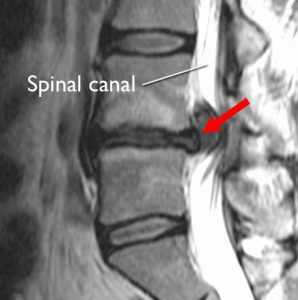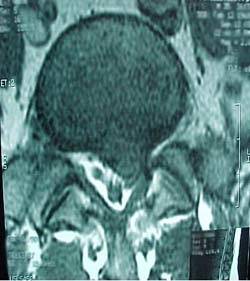Lumbar Discectomy Surgery/Microdiscectomy
For Back Pain Relief Caused By A Herniated Disc
• Herniated Disc Surgery Option
• The patient is Anesthetized & Asleep
A Lumbar Discectomy Surgery or Microdiscectomy is a procedure to remove pressure on a nerve in the low back caused by a herniated disc*. A small amount of bone in the back is removed to allow the surgeon access to the nerve. The nerve is then gently pushed aside and the disc pushing into the nerve is removed.
The procedure is done through a small incision in the low back and the microscope is used to provide optimal visualization of the nerves. The procedure can be performed through a standard small incision in the midline or it can be done through a small tube that is inserted through the skin. *Herniated discs are often referred to as slipped, bulging, ruptured, and retropulsion.
This surgery is generally performed to relieve leg pain caused by a herniated disc in the low back. While the disc is often soft, at times there may be a hard calcified fragment pressing on the nerve.
Before the operation begins, the anesthesiologist will put the patient to sleep. A general surgeon will often prepare the approach to the spine made.
Before the operation begins, the anesthesiologist will put the patient to sleep. The patient will then be turned on to their stomach in the operating room. This is done in an extremely careful manner to protect all pressure points.
After the appropriate antibiotics are given, an x-ray may be used to guide the placement of the incision. The incision may be in the midline or slightly off the midline if the operation is done through a tube.
When the back of the spine (lamina) is identified, a small portion is removed and a ligament, which covers the nerves, is partially removed. At this point, the nerve which is being compressed is gently moved aside, and the offending herniated disc which is pressing upon the nerve is seen. The herniated disc is now removed and additional disc fragments from the disc space are removed as well.
After assessing a satisfactory decompression of all the nerve roots, the wound is irrigated with an antibiotic solution and closed.
through the abdomen for the neurosurgeon. At this point, the neurosurgeon removes the disc material and implants the artificial disc. After doing so, the wound is closed and the patient is taken to the recovery room.
Patients are generally discharged home the day of or the day following surgery. The pain in the leg is typically significantly improved, although the patient may experience numbness in the leg, twinges of leg pain, pain around the incision and/or, at times, spasm of the back muscles. Medications will be given for this. This should improve within one to two weeks after surgery.

